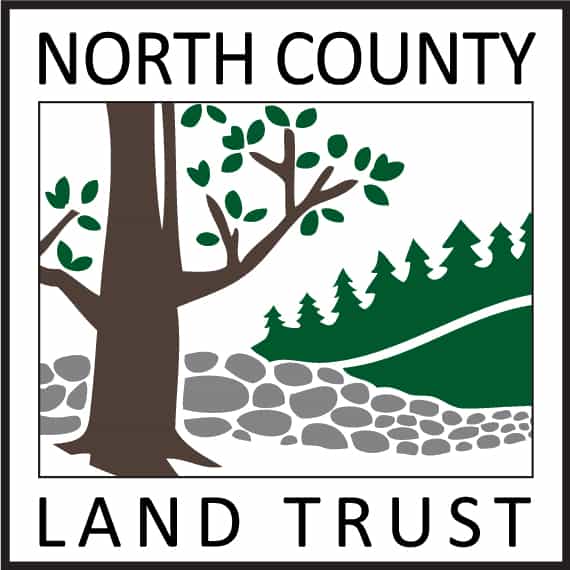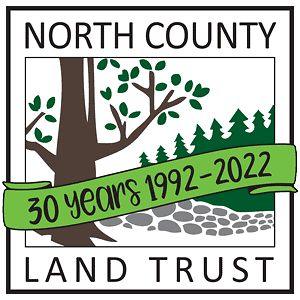 On June 4th, 2020 North County Land Trust hosted an Introduction to Invasive Plants in our Area webinar on the Zoom platform. The presenter was NCLT’s Executive Director Anna Wilkins who covered the ins and outs of what invasive plants in Central MA are, why it is important to identify them in the landscape, and how to devise a plan to control them on your own property. Using the webinar and the resources below there is a wealth of information to help you manage invasive plants on your property and make decisions about your land. Feel free to reach out to us with questions at info@northcountylandtrust.org if you can’t find the information you’re looking for here.
On June 4th, 2020 North County Land Trust hosted an Introduction to Invasive Plants in our Area webinar on the Zoom platform. The presenter was NCLT’s Executive Director Anna Wilkins who covered the ins and outs of what invasive plants in Central MA are, why it is important to identify them in the landscape, and how to devise a plan to control them on your own property. Using the webinar and the resources below there is a wealth of information to help you manage invasive plants on your property and make decisions about your land. Feel free to reach out to us with questions at info@northcountylandtrust.org if you can’t find the information you’re looking for here.
Presenter
Anna Wilkins is the Executive Director at North County Land Trust. Anna has worked in the field of conservation for over a decade in Massachusetts. She brings her training in Ecology and Natural Resource Management from Sterling College, VT, and experience managing over 2,000 acres of municipal conservation land as well as a love and passion for community engagement to NCLT. She is pleased she can focus on north central Massachusetts, where she was born and raised. Anna lives in Ashburnham, MA with her husband and two young children.
Resource Materials
Anna’s Presentation – PowerPoint presentation from the webinar session.
Identification, Control and Management Resources
SuAsCo CISMA – The SuAsCo CISMA (Cooperative Invasive Species Management Area) is a partnership of organizations that intend to manage and control invasive species defined by the geography of the Sudbury, Assabet, and Concord (SuAsCo) watershed. Thirty-six towns are part of the SuAsCo Watershed, and we are all connected by the Sudbury, Assabet, and Concord river system. The watershed covers approximately 377 square miles and includes a variety of upland habitats, wetland habitats, historic sites, scenic sites and recreational areas. The towns, state and federal government agencies, and environmental organizations that hold land in the watershed all share an interest in the work of the CISMA.
SuAsCo CISMA ID and Control for Common Invasives
SuAsCo CISMA list of additional learning resources
Go Botany – Want to know what that plant is? With our Simple Key, you can identify over 1,200 common native and naturalized New England plants! Observe closely, collect a sample or take a photo, answer some questions, and narrow down to the correct identification.
Native Plant Trust – Invasive Plant Species List New England
Invasive Plants Brochure – New England brochure of invasive plants from Native Plant Trust
The Invasive Plant Atlas of New England’s (IPANE) – Their mission is to create a comprehensive web-accessible database of invasive and potentially invasive plants in New England that will be continually updated by a network of professionals and trained volunteers. The database will facilitate education and research that will lead to a greater understanding of invasive plant ecology and support informed conservation management. An important focus of the project is the early detection of, and rapid response to, new invasions.
Mass Audubon: Common Invasive Plants in Massachusetts – Use this guide to help identify and manage common invasive plants in and around your home. See any of these in your town? Let your local conservation commission know.
Identify That Plant! – How to ID plants—in general. Folksy blog by Angelyn Whitmeyer.
The Invasive Plant Atlas of the United States – They are a collaborative project between the National Park Service, the University of Georgia Center for Invasive Species and Ecosystem Health, the Invasive Plant Atlas of New England and the Lady Bird Johnson Wildflower Center. The purpose of the Atlas is to assist users with identification, early detection, prevention, and management of invasive plants. The focus is on non-native invasive plant species impacting natural areas, excluding agricultural and other heavily developed and managed lands. Four main components are species information, images, distribution maps, and early detection reporting procedures. The Invasive Plant Atlas is one step in the effort to combat invasive species, preserve our natural landscapes and the native plants, animals, and other creatures that inhabit them.
Smartphone Apps
SEEK from iNaturalist.org – Found a mushroom, flower, or bug, and not sure what it is? Open up the Seek camera to see if it knows! Drawing from millions of wildlife observations on iNaturalist, Seek shows you lists of commonly recorded insects, birds, plants, amphibians, and more in your area. Scan the environment with the Seek Camera to identify organisms using the tree of life. Add different species to your observations and learn all about them in the process! The more observations you make, the more badges you’ll earn! Seek was made by iNaturalist, a joint Initiative of the California Academy of Sciences and the National Geographic Society, with support from Our Planet on Netflix, WWF, HHMI Tangled Bank Studios, and Visipedia.
The Outsmart Invasive Species – This project is a collaboration between the University of Massachusetts Amherst, the Massachusetts Department of Conservation and Recreation (MA DCR) and the Center for Invasive Species and Ecosystem Health at the University of Georgia.
The goal of the project is to strengthen ongoing invasive-species monitoring efforts in Massachusetts by enlisting help from citizens. The web- and smartphone-based approach enables volunteers to identify and collect data on invasive species in their own time, with little or no hands-on training.
By taking advantage of the increasing number of people equipped with iPhone or digital camera/web technology, this approach will expand the scope of invasive-species monitoring, and is an effort to help control outbreaks of new or emergent invasive species that threaten our environment.
What to Plant After Removal Resources
Ecological Landscape Alliance – Since its founding in 1992, the Ecological Landscape Alliance has been a leader in promoting sustainable approaches to landscape design, construction, and management. ELA’s commitment to innovative ideas and evidence-based practices has made the organization both a trusted resource and a vibrant community of landscape professionals and devoted gardeners.
Grown Native Massachusetts – Inspire people to action across the Commonwealth, on behalf of native plants and the diversity of life they support.
Native Plant Trust – We are nation’s first plant conservation organization and the only one solely focused on New England’s native plants. More than a century ago, when ecology was a new word, our founders organized what is now called Native Plant Trust to stop the destruction of native plants. Today, as native plants face the greatest wave of threats since the last mass extinction, we are still a national leader in native plant conservation, horticulture, and education. We save native plants in the wild, grow them for gardens and restorations, and educate others on their value and use.
We develop new insights, create cutting-edge tools, and foster collaborations that advance our own work and that of our peers. Our leadership and staff are internationally recognized as experts in their respective fields. We offer a wide range of resources and programs for all levels of interest and experience.
Ecological Gardening – Page from Native Plant Trust on ecological gardening.
Landscaping for Birds – Page from Mass Audubon about landscaping choices for bird habitat.
Specific Invasive Species Topics
Barberry/Lyme Connection – Article from Entomology Today about reduction of tick populations through management and reduction of Japanese Barberry.
Invasive Species and Poverty – Publication from The Global Invasive Species Programme providing a better understanding of the links between invasive species and poverty.
Facebook Groups
Native Plants of New England – Purpose of this group: The purpose of this group is promoting native plants and their role in a healthy environment. By native plants we mean those that, in general, were in New England before the early settlers brought plants from Europe. Learning to distinguish native species from introduced or non-native species, especially invasive ones, is another important goal of this website. For obvious reasons, we do NOT advocate the use of plants as food or medicine and reserve the right to delete such posts. This is not aien herbalism or foraging group.
Invasive Plant ID and Removal in North America – This is for those folks who are involved in ERADICATING, DESTROYING, ELIMINATING, AND RENDERING USELESS FOR ANY PURPOSE AT ALL, ANY AND ALL Non-Native Invasive Plants, terrestrial, aquatic, or exotic. Members may be interested in finding out more information or getting the identification of something they’ve found, or forward or write about something they just learned or have known for others to learn about. All levels of expertise are welcome, from beginners to experts. No question or problem is too insignificant.
North Central Nature – We’re a group of individuals with interests in the natural world, based out of the Lunenburg Mass area, in the works of forming. Draft mission statement: To foster relationships between humans and the natural world, through experience based learning and the sharing of knowledge, in an effort to promote awareness and environmental stewardship.
Funding Opportunities
MassWildlife Habitat Management Grant Program (MHMGP) – The MHMGP program encourages landowners to engage in active habitat management on their properties to benefit wildlife. Allowable activities/costs (partial list, see RFP for full list):
Direct costs for on the ground habitat improvements specifically designed to benefit wildlife will be eligible for reimbursement. All project costs must be approved in the agreed upon contract budget to be eligible for reimbursement.
Examples (not limited to) of eligible enhancements and/or practices: Mowing, brush hogging, heavy chipping, clearing of trees, contract grazing, control of invasive plants in the project area (mechanical and chemical), fencing for habitat protection, prescribed burning, woodland improvements (thinning, cutting or girdling of trees), tree planting of species beneficial to wildlife, nest site creation or installation of nesting structures, seeding/planting of native species, natural community enhancement, core habitat or critical natural landscape enhancements
(Grant Deadline Sept. 2, 2020)
Other Landowner Resources
MassWoods Landowner Programs – List of landowner programs on the MassWoods website noting available programs, which organizations administer them and where to learn more information.
